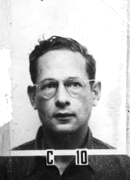Robert Serber
Robert Serber (born March 14, 1909 in Philadelphia , † June 1, 1997 in New York City ) was an American theoretical physicist who mainly dealt with nuclear physics.
Serber graduated from Lehigh University with a bachelor's degree in physics in 1930 and received his doctorate in 1934 under John H. van Vleck at the University of Wisconsin – Madison . After that Serber originally wanted in Eugene Wigner at Princeton University working, then joined but after a guest lecture Oppenheimer at the University of Michigan in Ann Arbor heard the very active group theory of Robert Oppenheimer at the University of California, Berkeley on . In 1938 he went to the University of Illinois at Urbana-Champaign as an Associate Professor , before going to the Manhattan Project in Los Alamos , led by Oppenheimer, in 1941 . Serber was Oppenheimer's right-hand man there and worked a. a. 1942 on the hydrodynamic theory of the bomb explosion ("Serber shock wave"), developed a method with Robert Wilson to calculate criticalities and wrote the introductory lectures on bomb physics given there, the "Los Alamos Primer". The nicknames for the three first nuclear bombs built ( Little Boy , Thin Man, Fat Man ) come from him. He was also in the first group of scientists to investigate the effects of the bombing on Hiroshima and Nagasaki in September 1945. After the war he returned to Berkeley as a professor of physics and was appointed professor at Columbia University in 1951 , where he headed the physics department in 1975 and retired in 1978.
As a theorist, Serber had the reputation of being able to respond very much to experimental physicists and to present the theory to them as practically as possible. B. in the lectures on nuclear physics that were later published as a book (which circulated as "Serber Says").
Serber was married twice and had two sons. He died of complications after surgery for a brain tumor.
Since 1952 he was a member of the National Academy of Sciences . In 1979 he was accepted into the American Academy of Arts and Sciences .
literature
- Lillian Hoddeson, Paul W. Henriksen, Roger A. Meade, and Catherine L. Westfall: Critical Assembly. A Technical History of Los Alamos During the Oppenheimer Years, 1943-1945 . Cambridge 1993
- Serber and Robert P. Crease: Peace and War. Reminiscences of a Life on the Frontiers of Science . Columbia University Press, New York 1998, ISBN 0-231-10546-0
- Serber: The Los Alamos Primer. The First Lectures on How to Build an Atomic Bomb . University of California Press, 1992, ISBN 0-520-07576-5 (original 1943 LA-1, published in 1965, annotated by Serber and edited by Richard Rhodes), version at LANL, pdf
- Serber: Serber Says. About Nuclear Physics . World Scientific, Singapore 1987
Web links
- obituary
- Serber's bibliography from the Alsos Digital Library for Nuclear Issues
- biography
- Oral History Interview 1996
- Oral History 1967
- Introduction by Serber to bomb physics, PDF file ( Memento from September 29, 2006 in the Internet Archive ) (3.00 MB)
- Biography at the APS
Remarks
- ↑ he even lived in his house for a year
- ↑ Based on Serber's memories from the novels or film adaptations of Dashiell Hammett such as the "Maltese Falcon".
- ↑ Originally he was supposed to fly on the plane in which the drop on Nagasaki was filmed, but he had to get off shortly before take-off because he had forgotten his parachute. In 1952 he was denied a security clearance that was necessary to attend a conference in Japan.
- ↑ partly because of political pressure in the McCarthy era. At Berkeley, an oath of political activity was required
| personal data | |
|---|---|
| SURNAME | Serber, Robert |
| BRIEF DESCRIPTION | American physicist |
| DATE OF BIRTH | March 14, 1909 |
| PLACE OF BIRTH | Philadelphia |
| DATE OF DEATH | June 1, 1997 |
| Place of death | New York City |
